Motion Relationships (SQA National 5 Physics): Revision Note
Exam code: X857 75
Motion relationships
Speed
The speed of an object is defined as:
The distance travelled per unit time
Speed can be calculated using the following relationship:
Where:
= speed, measured in metres per second (m s-1)
= distance travelled, measured in metres (m)
= time, measured in seconds (s)
Distance and speed are both scalar quantities with magnitude only
The direction of the object's motion is not described by speed
Examiner Tips and Tricks
Relationship triangles are really useful for knowing how to rearrange physics equations, such as the relationship between speed, distance, and time.
To use them:
Cover up the quantity to be calculated; this is known as the 'subject' of the equation
If the other two quantities are on the same line, this means they are multiplied
If one quantity is above the other, this means they are divided - make sure to keep the order of which is on the top and bottom of the fraction!

However, they are a tool to use until you feel confident in rearranging equations. They are not meant to be used in your exam. If you give an equation in triangle form in your exam, you will not be awarded the mark.
Average and instantaneous speed
The speedometer of a car gives a measure of instantaneous speed
For example, if the speedometer reads 50 mph (miles per hour), which is equivalent to 22 m s-1, it means that the car is travelling 22 metres every second that this speed is maintained
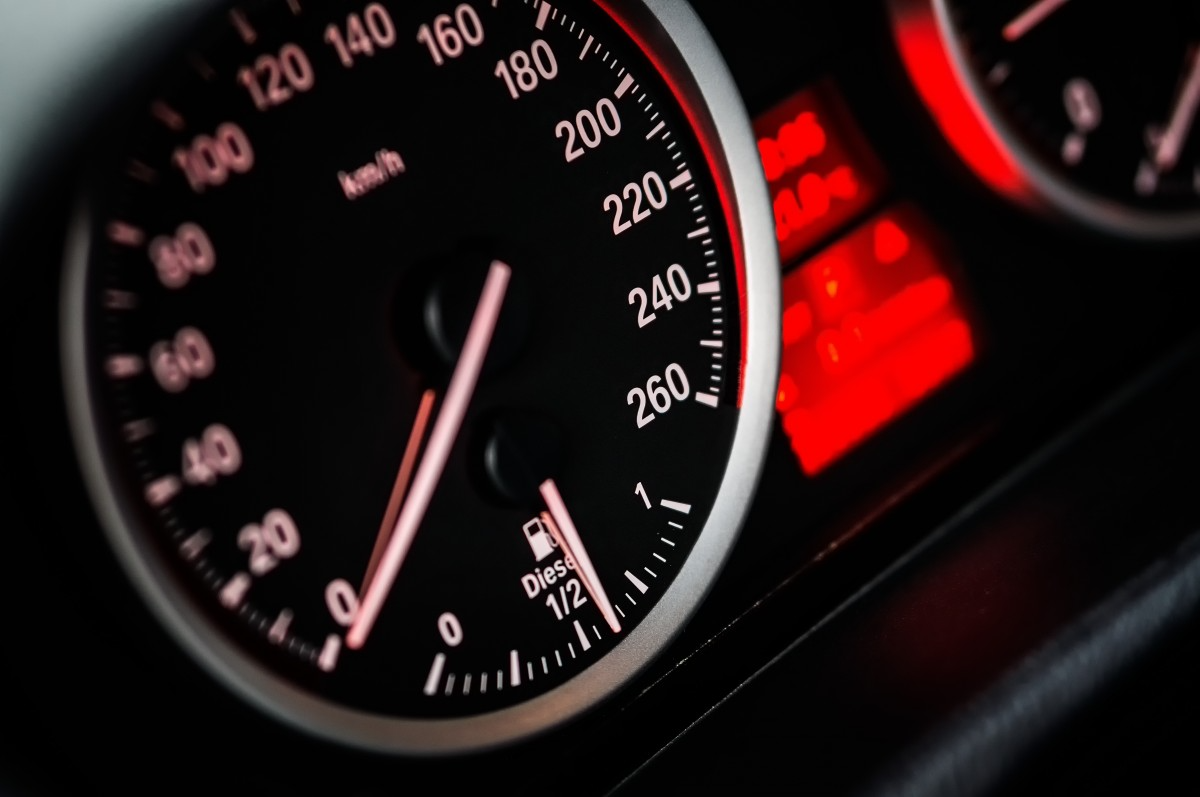
Image: Creative Commons licence from pxhere.com (opens in a new tab)
As the speed of the car changes, the speedometer will give a new value for the new instantaneous speed
The instantaneous speed is the speed at which an object travels in each instant of time
Average speed considers the total distance travelled and the total time taken
For example, the car will not travel at 22 m s-1 for its entire journey; it will speed up and slow down accordingly
Average speed can be calculated using the following relationship:
Where:
= average speed, measured in metres per second (m s-1)
= total distance travelled, measured in metres (m)
= total time taken, measured in seconds (s)
If the car travelled a total distance of 2000 metres and the whole journey took 3 minutes, or 180 seconds, then the average speed of the car is:
Map showing the distance travelled by a car
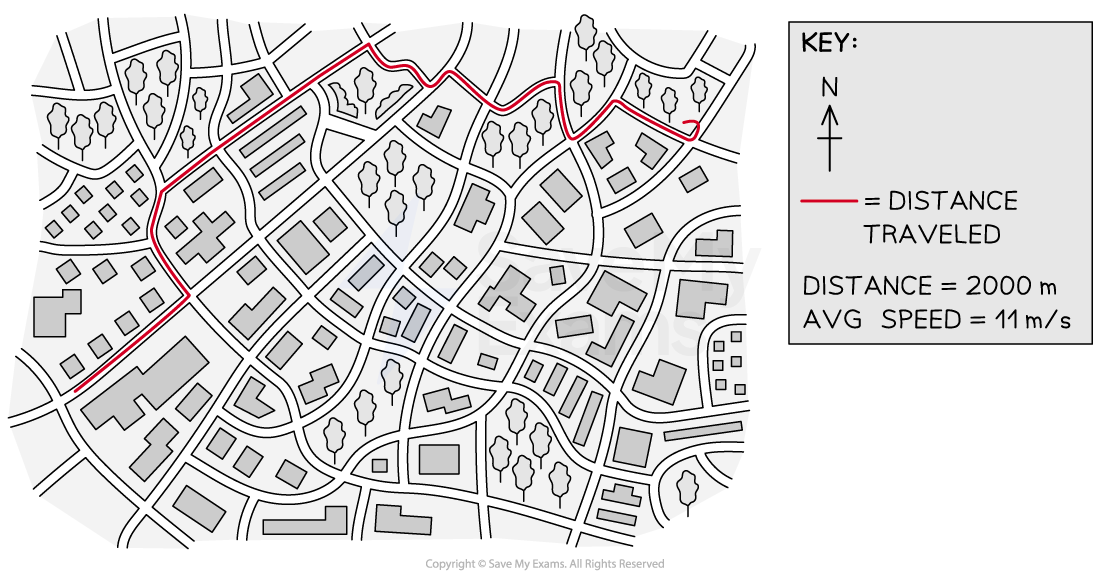
Examiner Tips and Tricks
A bar over the symbol of a quantity is the standard mathematical notation for the average value of that quantity, e.g. speed is represented by , so the average speed is represented by
.
Velocity
The velocity of an object is defined as:
The displacement per unit time
Velocity can be calculated using the following relationship:
Where:
= velocity, measured in metres per second (m s-1)
= displacement, measured in metres (m)
= time, measured in seconds (s)
Velocity is a vector quantity with both magnitude and direction
If an object travels with a constant speed but changes direction, then its velocity is changing
Therefore, it is possible for an object to travel at a constant speed without a constant velocity, but it is not possible for an object to travel at a constant velocity without a constant speed
The magnitude of an object's velocity is its speed
However, the magnitude of an object's average velocity is not its average speed
Comparing speed and velocity

Worked Example
A car travels north on a motorway at a speed of 33 m s-1.
Determine the displacement of the car in 2.0 minutes.
Answer:
Step 1: List the known quantities
Velocity, v = 33 m s-1 north
Time, t = 2.0 minutes
Step 2: Convert the values to SI units
1 minute = 60 s
Therefore, 2.0 minutes = 2.0 × 60 = 120 s
Step 3: Write out the correct relationship
Step 4: Substitute in the known values to calculate displacement
Step 5: Round the final answer to an appropriate number of significant figures
The least precise input value is 2 s.f.
Therefore, the answer can only be given to the same precision
Examiner Tips and Tricks
Always include the direction when referring to velocity or displacement, but not when referring to speed or distance. The exception to this is if a question asks for the 'magnitude', which means you only need to give the numerical value.
Average velocity
Average velocity also describes the whole journey of an object
It considers the total displacement rather than the distance
Average velocity can be calculated using:
Where:
= average velocity, measured in metres per second (m s-1)
= total displacement, measured in metres (m)
= total time taken, measured in seconds (s)
If the same car had a displacement of 1500 metres over its 3 minute journey, then the magnitude of the average velocity would be:
Notice how the average speed and average velocity have different magnitudes
The direction of the average velocity is in the same direction as the displacement
This could be found by drawing a straight line from start to finish and measuring the angle with a protractor, or calculating it using trigonometry if the scale of the map is known
Map showing the displacement of a car
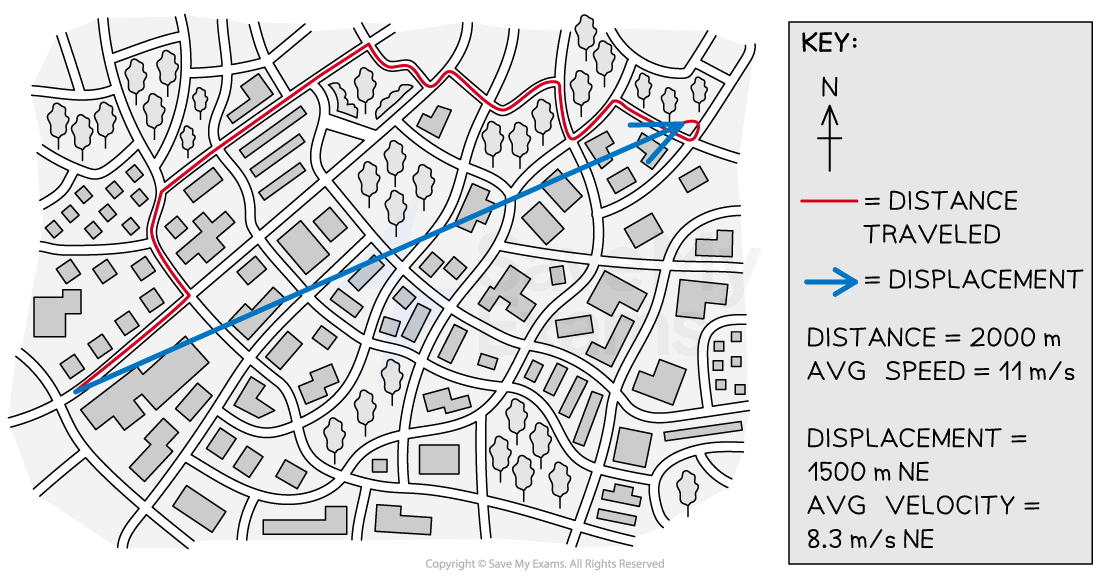
Positive and negative velocity
Since velocity is a vector quantity, it can have a positive or negative value
A positive velocity is typically assigned to the object's initial direction of motion
A negative velocity is typically assigned to the opposite direction to the object's initial velocity
If there is no initial direction of motion, then positive velocity is generally either:
forwards
to the right
upwards
However, mathematically, any direction can be assigned as positive as long as the opposing direction is negative
Examiner Tips and Tricks
Which ever direction you assign as positive, make sure you are consistent throughout your calculation.
Worked Example
The map below shows a teacher's route through the city on their way to work. The teacher travels 1.8 km north, and then 450 m east before parking their car. The journey takes 4 minutes.
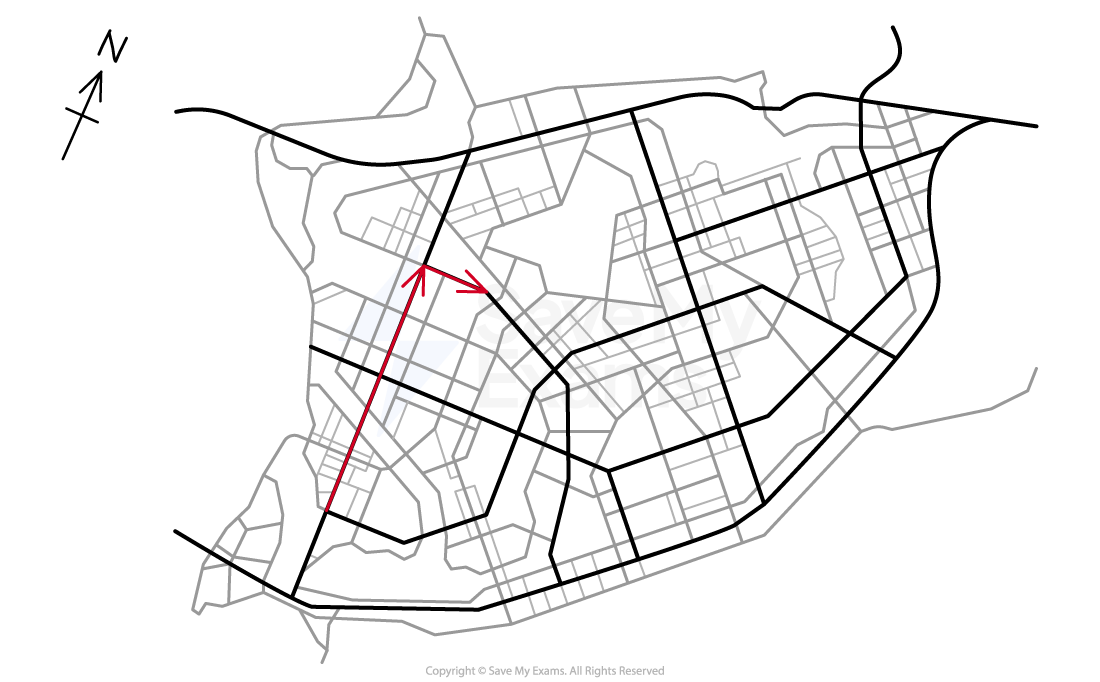
Which row in the table shows the teacher's average speed and average velocity for the journey?
Average speed | Average velocity | |
|---|---|---|
A | 7.7 m s-1 | 7.7 m s-1 at 014 |
B | 7.7 m s-1 at 014 | 7.7 m s-1 |
C | 9.4 m s-1 | 7.7 m s-1 at 014 |
D | 9.4 m s-1 at 014 | 9.4 m s-1 |
E | 9.4 m s-1 | 9.4 m s-1 at 014 |
The correct answer is C
Answer:
Step 1: List the known quantities
1 km = 1000 m
Displacement to the north = 1.8 km = 1.8 × 1000 = 1800 m
Displacement to the east = 450 m
1 minute = 60 s
Total time = 4 minutes = 4 × 60 = 240 s
Step 2: Calculate the average speed
Determine the total distance travelled
Determine the average speed
Therefore, the average speed is 9.4 m s-1, and it doesn't have a direction, so options A, B and D can be eliminated
Step 3: Determine the total displacement
The resultant displacement (blue arrow) is the vector sum of the two displacement vectors (red arrows)
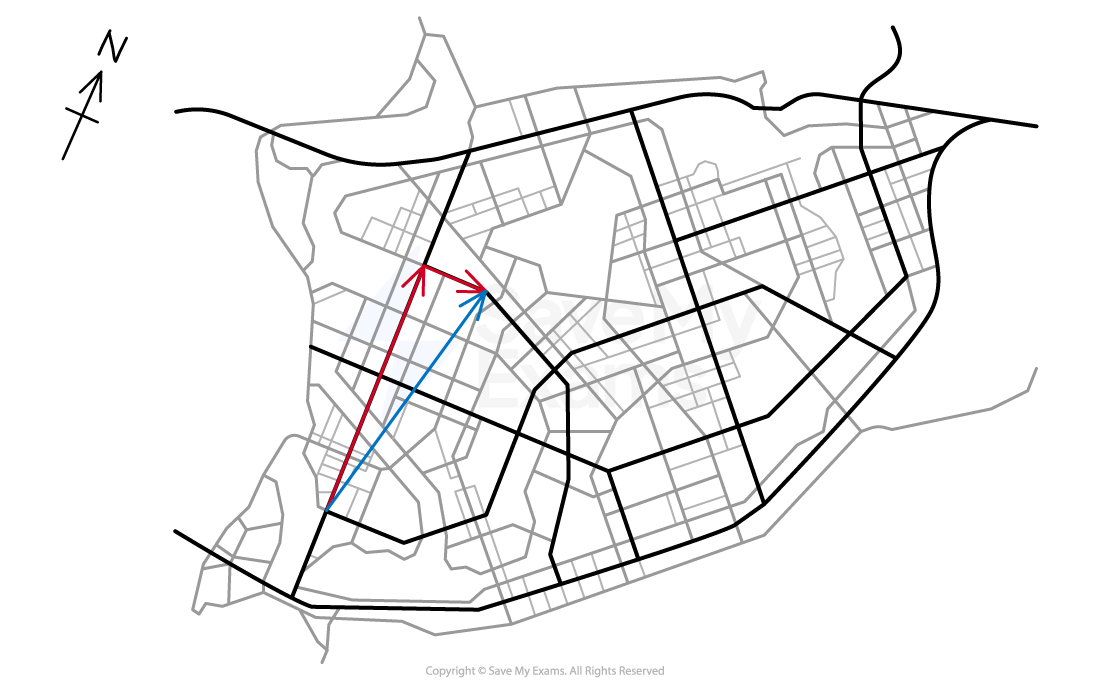
The magnitude of the resultant displacement can be found using Pythagoras' theorem:
The direction of the resultant displacement can be found using trigonometry:
North has a bearing of , therefore,
Step 4: Calculate the average velocity
The magnitude of the average velocity is
The direction of the average velocity is in the same direction as the resultant displacement
Therefore, the average velocity is 7.7 m s-1 at 014
This is option C
Examiner Tips and Tricks
It is best practice to convert units before you input the value into your calculation. You are less likely to forget and less likely to make mistakes this way.

Unlock more, it's free!
Did this page help you?